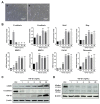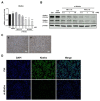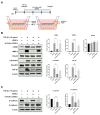Urine-Derived Stem Cell-Secreted Klotho Plays a Crucial Role in the HK-2 Fibrosis Model by Inhibiting the TGF-β Signaling Pathway
- PMID: 35563402
- PMCID: PMC9105028
- DOI: 10.3390/ijms23095012
Urine-Derived Stem Cell-Secreted Klotho Plays a Crucial Role in the HK-2 Fibrosis Model by Inhibiting the TGF-β Signaling Pathway
Abstract
Renal fibrosis is an irreversible and progressive process that causes severe dysfunction in chronic kidney disease (CKD). The progression of CKD stages is highly associated with a gradual reduction in serum Klotho levels. We focused on Klotho protein as a key therapeutic factor against CKD. Urine-derived stem cells (UDSCs) have been identified as a novel stem cell source for kidney regeneration and CKD treatment because of their kidney tissue-specific origin. However, the relationship between UDSCs and Klotho in the kidneys is not yet known. In this study, we discovered that UDSCs were stem cells that expressed Klotho protein more strongly than other mesenchymal stem cells (MSCs). UDSCs also suppressed fibrosis by inhibiting transforming growth factor (TGF)-β in HK-2 human renal proximal tubule cells in an in vitro model. Klotho siRNA silencing reduced the TGF-inhibiting ability of UDSCs. Here, we suggest an alternative cell source that can overcome the limitations of MSCs through the synergetic effect of the origin specificity of UDSCs and the anti-fibrotic effect of Klotho.
Keywords: chronic kidney disease; klotho; mesenchymal stem cells; renal fibrosis; urine-derived stem cells.
Conflict of interest statement
All authors declare that no support, financial or otherwise, has been received from any organization that may have an interest in the submitted work and there are no other relationships or activities that could appear to have influenced the submitted work. EHLBIO Co., LTD. had no role in the design of the study; in the collection, analyses, or interpretation of data; in the writing of the manuscript, or in the decision to publish the results.
Figures







Similar articles
-
Klotho inhibits transforming growth factor-beta1 (TGF-beta1) signaling and suppresses renal fibrosis and cancer metastasis in mice.J Biol Chem. 2011 Mar 11;286(10):8655-8665. doi: 10.1074/jbc.M110.174037. Epub 2011 Jan 5. J Biol Chem. 2011. PMID: 21209102 Free PMC article.
-
PAI-1 induction during kidney injury promotes fibrotic epithelial dysfunction via deregulation of klotho, p53, and TGF-β1-receptor signaling.FASEB J. 2021 Jul;35(7):e21725. doi: 10.1096/fj.202002652RR. FASEB J. 2021. PMID: 34110636 Free PMC article.
-
Dihydroartemisinin suppresses renal fibrosis in mice by inhibiting DNA-methyltransferase 1 and increasing Klotho.Acta Pharmacol Sin. 2022 Oct;43(10):2609-2623. doi: 10.1038/s41401-022-00898-3. Epub 2022 Mar 28. Acta Pharmacol Sin. 2022. PMID: 35347248 Free PMC article.
-
Negative regulators of TGF-β1 signaling in renal fibrosis; pathological mechanisms and novel therapeutic opportunities.Clin Sci (Lond). 2021 Jan 29;135(2):275-303. doi: 10.1042/CS20201213. Clin Sci (Lond). 2021. PMID: 33480423 Review.
-
Central role of dysregulation of TGF-β/Smad in CKD progression and potential targets of its treatment.Biomed Pharmacother. 2018 May;101:670-681. doi: 10.1016/j.biopha.2018.02.090. Epub 2018 Mar 22. Biomed Pharmacother. 2018. PMID: 29518614 Review.
Cited by
-
Characterization of Urine-Derived Stromal/Stem Cells from Healthy Dogs and Dogs Affected by Chronic Kidney Disease (CKD).Animals (Basel). 2025 Jan 16;15(2):242. doi: 10.3390/ani15020242. Animals (Basel). 2025. PMID: 39858242 Free PMC article.
-
Urine-derived stem cells: Promising advancements and applications in regenerative medicine and beyond.Heliyon. 2024 Mar 10;10(6):e27306. doi: 10.1016/j.heliyon.2024.e27306. eCollection 2024 Mar 30. Heliyon. 2024. PMID: 38509987 Free PMC article. Review.
-
MiR-556-3p mediated repression of klotho under oxidative stress promotes fibrosis of renal tubular epithelial cells.Sci Rep. 2025 Apr 9;15(1):12182. doi: 10.1038/s41598-025-85479-0. Sci Rep. 2025. PMID: 40204752 Free PMC article.
-
Fibrosis in Chronic Kidney Disease: Pathophysiology and Therapeutic Targets.J Clin Med. 2024 Mar 25;13(7):1881. doi: 10.3390/jcm13071881. J Clin Med. 2024. PMID: 38610646 Free PMC article. Review.
-
In vivo safety and biodistribution profile of Klotho-enhanced human urine-derived stem cells for clinical application.Stem Cell Res Ther. 2023 Dec 10;14(1):355. doi: 10.1186/s13287-023-03595-y. Stem Cell Res Ther. 2023. PMID: 38072946 Free PMC article.
References
-
- Kusek J.W., Greene P., Wang S.R., Beck G., West D., Jamerson K., Agodoa L.Y., Faulkner M., Level B. Cross-sectional study of health-related quality of life in African Americans with chronic renal insufficiency: The African American Study of Kidney Disease and Hypertension Trial. Am. J. Kidney Dis. 2002;39:513–524. doi: 10.1053/ajkd.2002.31401. - DOI - PubMed
MeSH terms
Substances
LinkOut - more resources
Full Text Sources
Medical

